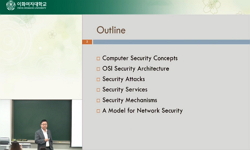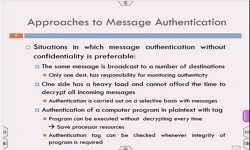Analyzing network traffic is the basis of dealing with network security issues. Most of the network security systems depend on the feature selection of network traffic data and the de-tection ability of malicious traffic in network can be improved by ...
http://chineseinput.net/에서 pinyin(병음)방식으로 중국어를 변환할 수 있습니다.
변환된 중국어를 복사하여 사용하시면 됩니다.
- 中文 을 입력하시려면 zhongwen을 입력하시고 space를누르시면됩니다.
- 北京 을 입력하시려면 beijing을 입력하시고 space를 누르시면 됩니다.



FAFS: A Fuzzy Association Feature Selection Method for Network Malicious Traffic Detection = FAFS: A Fuzzy Association Feature Selection Method for Network Malicious Traffic Detection
한글로보기https://www.riss.kr/link?id=A106560482
-
저자
( Yongxin Feng ) (Shenyang Ligong University) ; ( Yingyun Kang ) (Shenyang Ligong University) ; ( Hao Zhang ) (Shenyang Ligong University) ; ( Wenbo Zhang ) (Shenyang Ligong University)

- 발행기관
- 학술지명
- 권호사항
-
발행연도
2020
-
작성언어
-
- 주제어
-
등재정보
KCI등재,SCIE,SCOPUS
-
자료형태
학술저널
- 발행기관 URL
-
수록면
240-259(20쪽)
-
KCI 피인용횟수
0
- DOI식별코드
- 제공처
-
0
상세조회 -
0
다운로드
부가정보
다국어 초록 (Multilingual Abstract)
Analyzing network traffic is the basis of dealing with network security issues. Most of the network security systems depend on the feature selection of network traffic data and the de-tection ability of malicious traffic in network can be improved by the correct method of feature selection. An FAFS method, which is short for Fuzzy Association Feature Selection method, is proposed in this paper for network malicious traffic detection. Association rules, which can reflect the relationship among different characteristic attributes of network traffic data, are mined by association analysis. The membership value of association rules are obtained by the calculation of fuzzy reasoning. The data features with the highest correlation intensity in network data sets are calculated by comparing the membership values in association rules. The dimension of data features are reduced and the detection ability of malicious traffic detection algorithm in network is improved by FAFS method. To verify the effect of malicious traffic feature selection by FAFS method, FAFS method is used to select data features of different dataset in this paper. Then, K-Nearest Neighbor algorithm, C4.5 Decision Tree algorithm and Naïve Bayes algorithm are used to test on the dataset above. Moreover, FAFS method is also compared with classical feature selection methods. The analysis of experimental results show that the precision and recall rate of malicious traffic detection in the network can be signifi-cantly improved by FAFS method, which provides a valuable reference for the establishment of network security system.
참고문헌 (Reference)
1 R. Khosravanian, "Weight on drill bit prediction models : Sugeno-type and mamdani-type fuzzy inference systems compared" 36 : 280-297, 2016
2 Xiyue Deng, "Understanding Malware’s Network Behaviors using Fantasm" 1-11, 2017
3 Wen Gao, "The Divide-Conquer and Voting Strategy for Traffic Feature Selection" 43 (43): 795-799, 2015
4 Christian Rossow, "Sandnet : Network Traffic Analysis of Malicious Software" 77-78, 2011
5 Fei Tang, "Random Forest Missing Data Algorithms" 10 (10): 221-246, 2017
6 Frederico Coelho, "Multi-Objective Semi-Supervised Feature Selection and Model Selection Based on Pearson’s Correlation Coefficient" 6419 (6419): 509-516, 2010
7 "Modbus_traffic"
8 "KDDCup1999Data"
9 Zhihong Zhang, "Joint hypergraph learning and sparse regression for feature selection" 63 : 291-309, 2017
10 T. V. Avdeenko, "Integration of Case-based and Rule-based Reasoning Through Fuzzy Inference in Decision Support Systems" 103 : 447-453, 2017
1 R. Khosravanian, "Weight on drill bit prediction models : Sugeno-type and mamdani-type fuzzy inference systems compared" 36 : 280-297, 2016
2 Xiyue Deng, "Understanding Malware’s Network Behaviors using Fantasm" 1-11, 2017
3 Wen Gao, "The Divide-Conquer and Voting Strategy for Traffic Feature Selection" 43 (43): 795-799, 2015
4 Christian Rossow, "Sandnet : Network Traffic Analysis of Malicious Software" 77-78, 2011
5 Fei Tang, "Random Forest Missing Data Algorithms" 10 (10): 221-246, 2017
6 Frederico Coelho, "Multi-Objective Semi-Supervised Feature Selection and Model Selection Based on Pearson’s Correlation Coefficient" 6419 (6419): 509-516, 2010
7 "Modbus_traffic"
8 "KDDCup1999Data"
9 Zhihong Zhang, "Joint hypergraph learning and sparse regression for feature selection" 63 : 291-309, 2017
10 T. V. Avdeenko, "Integration of Case-based and Rule-based Reasoning Through Fuzzy Inference in Decision Support Systems" 103 : 447-453, 2017
11 Wei Wang, "HAST-IDS : Learning Hierarchical Spatial-Temporal Features Using Deep Neural Networks to Improve Intrusion Detection" 6 (6): 1792-1806, 2017
12 Jundong Li, "Feature selection: a data perspective" 50 : 94:1-94:5, 2017
13 Mohd Mahmood Ali, "Extracting useful rules through improved decision tree induction using information entropy" 3 (3): 27-41, 2013
14 Qilei Yin, "Detection of Attack Time Series Association Rules Based on Apriori Algorithms" (9) : 2-7, 2014
15 "DARPA Intrusion Detection Evaluation"
16 Jose Andre Morales, "Analyzing and exploiting network behaviors ofMalware" 50 : 20-34, 2010
17 Sergio Ramírez-Gallego, "An information theory-based feature selection framework for big data under apache spark" 48 : 1441-1453, 2018
18 A. Salama, "Adaptive Sampling Technique for Computer Network Traffic Parameters Using a Combination of Fuzzy System and Regression Model" 206-211, 2017
19 Razieh Sheikhpour, "A survey on semi-supervised feature selection methods" 64 : 141-158, 2017
20 Xingbin Sun, "A feature selection method for multi-class network traffic" 34 (34): 568-571, 2017
21 Xingbin Sun, "A Statistical Frequency-Based Method for Network Traffic Feature Selection" 37 (37): 2483-2487, 2016
동일학술지(권/호) 다른 논문
-
- 한국인터넷정보학회
- ( Xiaorong Xu )
- 2020
- KCI등재,SCIE,SCOPUS
-
Resource allocation in downlink SWIPT-based cooperative NOMA systems
- 한국인터넷정보학회
- ( Longqi Wang )
- 2020
- KCI등재,SCIE,SCOPUS
-
SLNR-based Precoder Design in Multiuser Interference Channel with Channel Estimation Error
- 한국인터넷정보학회
- ( Bangwon Seo )
- 2020
- KCI등재,SCIE,SCOPUS
-
Dynamic Synchronous Phasor Measurement Algorithm Based on Compressed Sensing
- 한국인터넷정보학회
- ( Huanan Yu )
- 2020
- KCI등재,SCIE,SCOPUS
분석정보
인용정보 인용지수 설명보기
학술지 이력
| 연월일 | 이력구분 | 이력상세 | 등재구분 |
|---|---|---|---|
| 학술지등록 | 한글명 : KSII Transactions on Internet and Information Systems 외국어명 : KSII Transactions on Internet and Information Systems | ||
| 2023 | 평가예정 | 해외DB학술지평가 신청대상 (해외등재 학술지 평가) | |
| 2020-01-01 | 평가 | 등재학술지 유지 (해외등재 학술지 평가) |  |
| 2013-10-01 | 평가 | 등재학술지 선정 (기타) |  |
| 2011-01-01 | 평가 | 등재후보학술지 유지 (기타) |  |
| 2009-01-01 | 평가 | SCOPUS 등재 (신규평가) |  |
학술지 인용정보
| 기준연도 | WOS-KCI 통합IF(2년) | KCIF(2년) | KCIF(3년) |
|---|---|---|---|
| 2016 | 0.45 | 0.21 | 0.37 |
| KCIF(4년) | KCIF(5년) | 중심성지수(3년) | 즉시성지수 |
| 0.32 | 0.29 | 0.244 | 0.03 |




 ScienceON
ScienceON KISS
KISS






